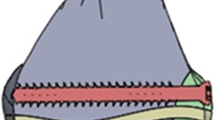Abstract
In this study, biomechanical behaviors of three different screw materials (stainless steel, titanium and cobalt–chromium) have analyzed to fix with triangle fixation under axial loading in femoral neck fracture and which material is best has been investigated. Point cloud obtained after scanning the human femoral model with the three dimensional (3D) scanner and this point cloud has been converted to 3D femoral model by Geomagic Studio software. Femoral neck fracture was modeled by SolidWorks software for only triangle configuration and computer-aided numerical analyses of three different materials have been carried out by AnsysWorkbench finite element analysis (FEA) software. The loading, boundary conditions and material properties have prepared for FEA and Von-Misses stress values on upper and lower proximity of the femur and screws have been calculated. At the end of numerical analyses, the best advantageous screw material has calculated as titanium because it creates minimum stress at the upper and lower proximity of the fracture line.
Graphical Abstract












Similar content being viewed by others
References
Sykaras N, Iacopino AM, Marker VA, Triplett RG, Woody RD. Implant materials, designs, and surface topographies: their effect on osseointegration. A literature review. Int J Oral Maxillofac Implants. 2000;15(5):675–90.
Verdonschot N, Huiskes R. The effects of cement-stem debonding in THA on the long-term failure probability of cement. J Biomech. 1997;30(8):795–802. doi:10.1016/S0021-9290(97)00038-9.
Andress H, Kahl S, Kranz C, Gierer P, Schürmann M, Lob G. Clinical and finite element analysis of a modular femoral prosthesis consisting of a head and stem component in the treatment of pertrochanteric fractures. J Orthop Trauma. 2000;14(8):546–53.
Waide V, Cristofolini L, Stolk J, Verdonschot N, Boogaard GJ, Toni A. Modelling the fibrous tissue layer in cemented hip replacements: experimental and finite element methods. J Biomech. 2004;37(1):13–26. doi:10.1016/S0021-9290(03)00258-6.
Colombi P. Fatigue analysis of cemented hip prosthesis: model definition and damage evolution algorithms. Int J Fatigue. 2002;24(8):895–901. doi:10.1016/S0142-1123(01)00203-1.
Senalp AZ, Kayabasi O, Kurtaran H. Static, dynamic and fatigue behavior of newly designed stem shapes for hip prosthesis using finite element analysis. Mater Des. 2007;28(5):1577–83. doi:10.1016/j.matdes.2006.02.015.
Kayabaşı O, Yüzbasıoğlu E, Erzincanlı F. Static, dynamic and fatigue behaviors of dental implant using finite element method. Adv Eng Softw. 2006;37(10):649–58. doi:10.1016/j.advengsoft.2006.02.004.
Gok K, Inal S. Biomechanical comparison using finite element analysis of different screw configurations in the fixation of femoral neck fractures. Mech Sci. 2015;6(2):173–9. doi:10.5194/ms-6-173-2015.
Várady T, Martin RR, Cox J. Reverse engineering of geometric models—an introduction. Comput-Aided Des. 1997;29(4):255–68. doi:10.1016/S0010-4485(96)00054-1.
Goffin JM, Pankaj P, Simpson AH. The importance of lag screw position for the stabilization of trochanteric fractures with a sliding hip screw: a subject-specific finite element study. J Orthopaed Res. 2013;31(4):596. doi:10.1002/jor.22266.
Yuan-Kun T, Yau-Chia L, Wen-Jen Y, Li-Wen C, You-Yao H, Yung-Chuan C et al. editors. Temperature rise simulation during a Kirschner pin drilling in bone. Bioinformatics and biomedical engineering, 2009. ICBBE 2009. 3rd International Conference on; 2009 11–13 June 2009; Beijing.
Staiger MP, Pietak AM, Huadmai J, Dias G. Magnesium and its alloys as orthopedic biomaterials: a review. Biomaterials. 2006;27(9):1728–34. doi:10.1016/j.biomaterials.2005.10.003.
Gok K, Inal S, Gok A, Pinar AM. Biomechanical effects of three different configurations in Salter Harris type 3 distal femoral epiphyseal fractures. J Braz Soc Mech Sci Eng. 2016;1–9. doi:10.1007/s40430-016-0666-8.
Author information
Authors and Affiliations
Corresponding author
Ethics declarations
Conflict of interest
The authors declare that they have no competing interests.
Rights and permissions
About this article
Cite this article
Gok, K., Inal, S., Gok, A. et al. Comparison of effects of different screw materials in the triangle fixation of femoral neck fractures. J Mater Sci: Mater Med 28, 81 (2017). https://doi.org/10.1007/s10856-017-5890-y
Received:
Accepted:
Published:
DOI: https://doi.org/10.1007/s10856-017-5890-y




